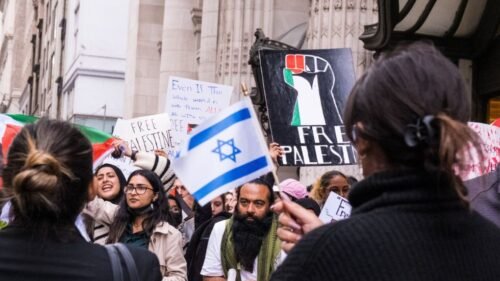Let the secular commemorate and the religious pray for the victims. We mourn the roughly 1,200 Israelis murdered on October 7, 2023, and the over 65,000 Palestinians killed since (most of them civilians) in a place where famine is officially confirmed. We hold in our hearts the grieving families on both sides and the injured who will carry scars for years to come.
But we should also ask: Why is October 7 treated as a zero point? Who decided that? The French historian François Hartog reminds us that dividing time into “before” and “after” is never neutral. He calls it a regime of historicity, the way communities shape their sense of past, present and future. In our presentist age, the present dominates, bending both past and future to its needs. Declaring October 7 as “Year Zero” is exactly that: a way of reorganizing memory around one rupture while pushing decades of siege, dispossession and occupation into the shadows.
How political narratives create beginnings
We have seen this before. February 24, 2022, is remembered as the beginning of Russia’s war in Ukraine, when tanks rolled toward Kyiv, Ukraine, and missiles fell across the country. Yet the conflict did not start there. Russia annexed Crimea in 2014, redrawing European borders by force. In Ukraine’s Donbas region, war had already killed more than 14,000 people over eight years, long before the “official” invasion. By focusing on 2022, the deeper arc of Russian expansionism, NATO tensions and Ukraine’s Maidan revolution gets folded into a single day.
The same pattern appears with June 28, 1914, the date of the assassination of Austrian Archduke Franz Ferdinand, which textbooks still call the spark of World War I. Assassin Gavrilo Princip’s shot mattered because Europe was already a powder keg: great‑power alliances, an arms race, decades of mounting colonial competition and regional destabilization caused by the Balkan Wars. Teaching 1914 as the sole “start” of World War I ignores the long fuse that had been burning.
Even the Russian Revolution is commonly dated to October 1917, when the Bolsheviks seized power. By then, Tsar Nicholas II of Russia had already abdicated after the February Revolution. World War I bled Russia dry, and workers’ and soldiers’ councils were already challenging authority. The October Revolution was decisive, but Soviet memory later fixed it as the singular start, erasing the February movement and the years of hunger, strikes and mutinies that made revolution inevitable.
History almost never begins on a single day. These dates are chosen because they make stories easier to tell — stories that comfort one community while erasing another.
And yet, not all ruptures are the same. When Mount Vesuvius erupted in 79 AD, burying Pompeii, nature itself imposed the beginning and the end. No state, no narrative was needed to stamp the date in memory.
Human conflicts aren’t like that. October 7, like February 24 or June 28, is not a natural eruption but a chosen symbol, a shorthand for histories that many would rather compress or forget. When the rupture is human, we have to ask: Who declared it? What gets silenced in the process? To stop at October 7 is to be duped, to be carried along by a story that comforts power and erases continuity.
Sacred rhythms of time
There is another way to build time. Polish-American Rabbi Abraham Joshua Heschel called the Sabbath a “palace in time,” a cathedral made of hours instead of stone. It is temporal architecture: continuity rather than rupture, a rhythm that holds communities together and resists the endless demands of commerce and domination. American journalist Judith Shulevitz describes the Sabbath as “counter‑time,” a disruption of ordinary chronology. And it isn’t just Jewish: Christian Sunday, Muslim Friday and Jewish Sabbath all show how sacred intervals bind communities through shared time.
Time can therefore be structured to include or exclude. It can be continuity, like Sabbaths and Sundays, or it can be rupture, like political anniversaries. Declaring October 7 as Year Zero isn’t neutral. It asks us to grieve one people’s suffering in isolation while pushing another’s into oblivion. If time is truly for community, remembrance must hold all griefs together or it isn’t remembrance at all.
A more unusual example illustrates this point. The Hopi and Navajo tribes have ritual calendars tied to agricultural and cosmic cycles, where ceremonies renew harmony rather than move forward. The lesson is that time structures community by anchoring people in cycles of land, ancestors and renewal, quite different from the ruptures we see in a Western, commodity‑driven view of time. In Hindu cosmology, time is vast and cyclical: yugas (epochs) and kalpas (cosmic cycles lasting billions of years). Festivals such as Diwali or Holi punctuate time as reenactments of myth, not as historical beginnings.
When memory becomes a weapon
Even within Judaism, voices warn against weaponizing memory. American Rabbi Yisroel Dovid Weiss has warned that Israeli Prime Minister Benjamin Netanyahu’s war policies betray Jewish ethics and put Jews everywhere in danger by fueling antisemitism. Weaponized memory doesn’t just endanger the “other” — it endangers the very community that claims it.
This is where we need to distinguish between two very different uses of time and, therefore, commemoration of anniversaries. On one hand, historiography can be bent to political and economic interests: It turns a date into a rupture, a “before and after,” and organizes memory in ways that serve power. October 7 being treated as Year Zero is an example of this; it makes one story total while pushing others to the margins.
We have seen this before. The Holocaust, one of the greatest wounds of the 20th century, can be remembered as a universal warning against dehumanization — never again for anyone — or it can be weaponized to silence criticism and justify new forms of domination. When memory is instrumentalized, it loses its power to unite and heal; it becomes another tool of division.
On the other hand, ceremony and remembrance can build community. In the rabbinical tradition, the Sabbath is not a zero point but a rhythm, a weekly refounding of belonging. Heschel called it a palace in time: not history written against someone, but time consecrated for everyone. Here, remembrance is not about erasing or dividing, but about reconciling and holding grief together.
Toward shared remembrance and healing
Commemoration remains essential. We owe it to the dead and the survivors. Now the kind of commemoration we need is not one that hardens borders between peoples, but one that creates space for community across them. Hartog reminds us that societies always build their own regimes of historicity; Heschel shows us that time can be a sanctuary, not a battlefield.
If peace is to be rebuilt, it will not come from zero points imposed by politics. It will come from choosing a different architecture of time and symbols, one that resists manipulation, embraces continuities and allows us to mourn together. True remembrance is not a prison of the present; it is a palace to be built by all.
[Kaitlyn Diana and Lee Thompson-Kolar edited this piece.]
The views expressed in this article are the author’s own and do not necessarily reflect Fair Observer’s editorial policy.
Support Fair Observer
We rely on your support for our independence, diversity and quality.
For more than 10 years, Fair Observer has been free, fair and independent. No billionaire owns us, no advertisers control us. We are a reader-supported nonprofit. Unlike many other publications, we keep our content free for readers regardless of where they live or whether they can afford to pay. We have no paywalls and no ads.
In the post-truth era of fake news, echo chambers and filter bubbles, we publish a plurality of perspectives from around the world. Anyone can publish with us, but everyone goes through a rigorous editorial process. So, you get fact-checked, well-reasoned content instead of noise.
We publish 3,000+ voices from 90+ countries. We also conduct education and training programs
on subjects ranging from digital media and journalism to writing and critical thinking. This
doesn’t come cheap. Servers, editors, trainers and web developers cost
money.
Please consider supporting us on a regular basis as a recurring donor or a
sustaining member.
Will you support FO’s journalism?
We rely on your support for our independence, diversity and quality.








Comment